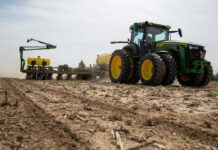MANHATTAN, Kan. — If you’re planning a trip to the dog park or a walk around a crowded park with your new puppy, you might want to wait a few weeks.
A Kansas State University veterinarian says taking your puppy out before it has been fully vaccinated for parvovirus could be deadly, especially at this time of year.
“Parvovirus — parvo — is a highly contagious virus that is something we do see year-round because it is always in the environment, but the Veterinary Health Center has been seeing more cases recently,” said Susan Nelson, clinical associate professor of clinical sciences.
Patients increasing
The increased number of cases is because the weather is nicer, which is a better environment for the virus to survive, and owners are taking advantage of the warmer temperatures to take their pets outside and interact with other dogs. But owners may not realize their puppy is at risk of getting parvo until they are fully vaccinated, according to Nelson.
“We usually see cases in young dogs, primarily puppies, that have had one vaccine as a puppy but didn’t complete the series or had no vaccines at all,” Nelson said. “This is definitely a preventable disease, so it’s important when you have puppies to get them into your veterinarian starting around 6 to 8 weeks of age for their first vaccine of what is commonly known as their ‘puppy series.’ Then they will need to get that vaccine every three to four weeks and receive their last booster around 14 to 16 weeks of age for the best chance of avoiding parvo and other diseases included in this vaccine series. They aren’t considered fully protected until a few weeks after that final dose at 14 to 16 weeks of age.”
Protection is necessary
Nelson said the number of shots may concern pet owners, but the protection is vital. A mother gives immunity to her pups through her milk. As long as this immunity is around, it will keep the puppy from responding to a vaccine. While the mother’s protection is good for the puppy, at some point it goes away.
If it has already rendered a vaccine ineffective, it leaves the puppy at risk for infection until the next round of boosters
For some pups, mom’s immunity disappears as early as 6 weeks of age, while for others, around 14 to 16 weeks of age. To protect as many puppies as possible, vaccines are started around 6 to 8 weeks of age and ended around 14 to 16 weeks.
One exception
During this vaccination period, Nelson said to avoid city parks, dog parks, pet stores that allow animals inside, and any place with dogs of questionable vaccine status.
One exception is puppy obedience classes. Nelson points out that socialization is critical at this time and the risk of parvovirus is much lower in these classes, which require all dogs to be vaccinated.
A puppy can start the classes one week after receiving its first set of “puppy shots.” Another way to socialize your puppy is to let it play with your friends’ or family’s dogs that you know are current on their vaccines.
While waiting until a little after 16 weeks of age to go to dog parks can be inconvenient, Nelson says it may save your dog’s life.
“The first symptoms of parvo are typically a fever with severe lethargy and depression,” Nelson said. “The dog then stops eating and begins vomiting, usually several times daily. Profuse diarrhea, which is often bloody, then develops. During the course of the disease, the dog becomes profoundly dehydrated. The virus destroys the lining of the intestinal tract, then bacteria move in and release toxins.
“The only treatment is supportive care and intensive therapy. They are put in strict isolation because it is highly contagious to other dogs,” she said. “Without any type of treatment, most infected dogs will die from the disease. And even with aggressive therapy, some dogs won’t make it. It can be very costly to treat them. Your best bet is prevention and keeping up with the vaccine series.”
Very contagious
Parvovirus is most prevalent in dogs 6 weeks to 6 months of age and can be picked up through contaminated feces, tracked in on shoes and through sharing harnesses, collars or food and water bowls. It is resistant to many common household cleaners other than bleach. It can survive outdoors for months up to years in the right conditions. It also can live in the house at room temperature for up to two months.
If you do suspect your puppy has parvo, contact your veterinarian immediately.












